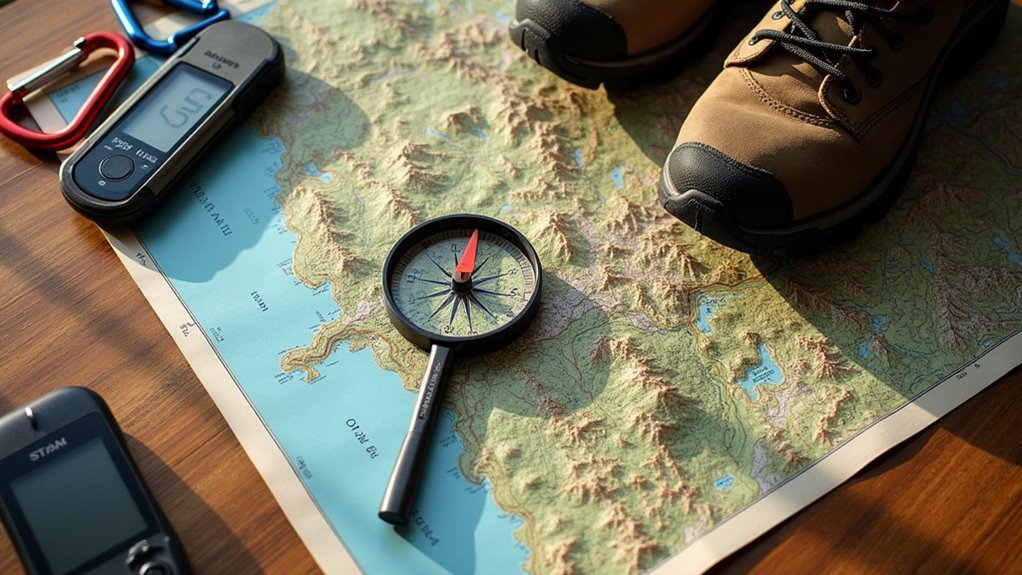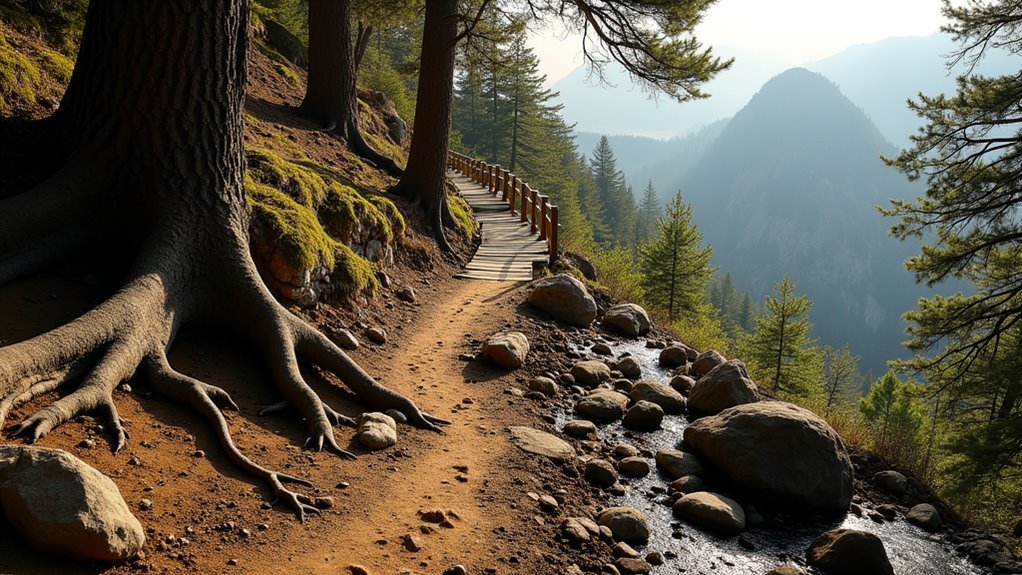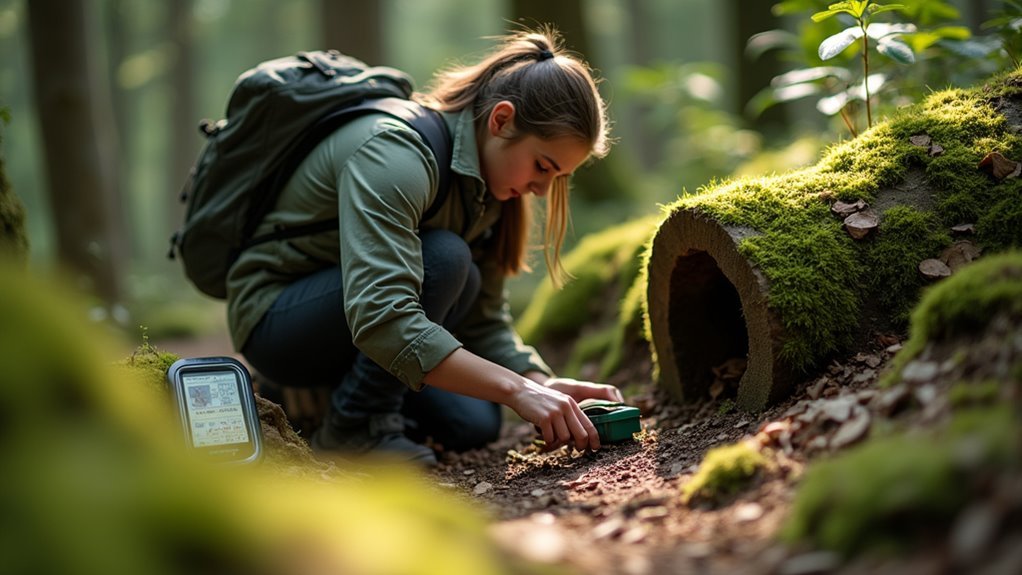Some of the links in this article may be affiliate links. If you make a purchase through these links, we may earn a small commission at no extra cost to you. Thank you.
I’ve been setting geocaches for eight years now, and if there’s one thing I’ve learned, it’s that rating your hide correctly matters more than you might think. Assigning the right D/T numbers isn’t just about following guidelines—it’s about respecting searchers’ time and safety. I’ve seen too many frustrated faces when a supposedly “easy” cache required specialized equipment or knowledge. Trust me, nothing ruins the geocaching experience faster than unexpected challenges. So how exactly should you approach this critical part of cache creation?
Understanding the Difficulty and Terrain (D/T) Rating Scale

When you’re first getting into geocaching, you’ll quickly notice the D/T rating system that appears on every cache listing.
I’ve found this scale to be absolutely essential, but also pretty subjective.
The Difficulty rating measures the intellectual challenge – things like solving puzzles or spotting a well-camouflaged container.
Difficulty ratings assess mental challenges—whether it’s cracking a complex puzzle or finding that expertly hidden micro under a lamppost skirt.
Puzzle writers often struggle with this one, and I always tell them to round up if they’re unsure.
GPS coordinates might get you close, but the real challenge begins there!
Meanwhile, Terrain ratings focus on physical demands.
Is it a quick parking lot grab or a five-mile hike through wilderness?
Guidelines suggest considering all factors that affect accessibility.
I’ve seen cache ratings change dramatically after review and feedback – like when that boardwalk disappears and a 2-star suddenly becomes a 4!
Key Factors That Impact Difficulty Ratings
Now that we’ve covered the basics of D/T ratings, let’s look at what actually goes into those difficulty numbers.
When I’m rating a cache, I’ve found that multiple factors can greatly impact that final number.
The Geocaching Help Center provides guidelines, but there’s still considerable subjectivity involved.
Here are the key factors that affect difficulty ratings:
- Personal experiences – your own familiarity with subjects like linguistics or movies can make you underrate challenges that others might find tough
- Feedback to assess accuracy – beta testing and community discussions about global positioning help refine ratings
- Hider experience – the more caches you’ve found yourself, the better you’ll be able to assess if a feature is truly difficult
Assessing Terrain Challenges Accurately

When I’m evaluating terrain challenges for mountain caches, I’ve found that access methods make a huge difference – sometimes I’ll bump a rating from 1.5 to 3.5 just because you’ll need to hike instead of drive.
I also think it’s essential to take into account seasonal variations, since that gentle forest path in summer might become a treacherous snow-covered nightmare by December.
If you’re unsure about which terrain rating to assign, I always recommend going higher rather than lower – it’s better to pleasantly surprise cachers than to watch them struggle with equipment they didn’t bring.
Mountain Access Considerations
Why do mountain caches often receive higher terrain ratings than their flatland counterparts?
Well, the Adventure in Geocaching changes dramatically when you’re tackling elevation!
In my experience with GPS units, mountain access presents unique challenges that directly impact terrain ratings.
I’ve found that many Guidelines for mountain cache ratings consider factors beyond just the hike itself.
Here are 3 key mountain access considerations:
- Vehicle requirements – a cache needing a 4×4 vehicle automatically increases the terrain rating
- Seasonal accessibility – what’s a T2 in summer might become a T4 when winter facilities are removed
- Distance factor – a cache that could be driven to (T1.5) becomes T3.5 when requiring a full hike
Seasonal Rating Adjustments
Seasonal adjustments to geocache ratings aren’t just helpful—they’re essential for keeping geocachers safe and prepared.
I’ve seen terrain ratings shift dramatically when environments change—like that cache where a boardwalk removal turned a simple 2 into a challenging 4.
When you’re maintaining caches, you need to monitor access changes throughout the year.
Did winter snow make that path treacherous?
Maybe your summer-friendly cache is underwater during spring floods?
These seasonal factors matter tremendously.
I think real-world feedback is your best guide for rating updates.
If cachers consistently report difficulty levels beyond your original assessment, it’s time for geocache adjustments.
Rating Puzzle Caches: Intellectual vs. Physical Challenges
When rating puzzle caches, I’m constantly balancing the intellectual challenge of solving the puzzle against the physical effort needed to actually find the container.
I’ve learned from Sven’s approach that it’s important to evaluate how specialized knowledge—whether it’s linguistics, movie trivia, or flag identification—can dramatically affect a puzzle’s difficulty level.
After creating my first few puzzle caches, I now use feedback from fellow cachers to calibrate my ratings, sometimes adjusting by half a point when I’ve misjudged how Google might make certain puzzles easier than I initially thought.
Mental Complexity Assessment
How do you accurately rate the mental demands of a puzzle cache when the intellectual challenge and physical effort are completely different beasts?
I’ve learned that reviewing any feedback from beta testers is essential.
When I created my first puzzle cache, I initially overrated it because the subject was familiar to me but not to others.
When evaluating mental complexity, consider:
- How specialized is the knowledge required? Rate higher for niche subjects.
- Are there tools (like Google) that make solving easier? Adjust accordingly.
- What’s the median rating from your fellow geocachers who tested it?
I think separating the intellectual rating from physical difficulty helps create fair assessments.
Ask your fellow geocachers questions for guidance—they’re usually happy to discuss creating Adventures that challenge minds appropriately.
Separating Challenge Types
Separating puzzle cache challenges into their intellectual and physical components isn’t just helpful—it’s essential for accurate ratings.
When I create a puzzle cache, I need to distinguish between the brain work and the legwork.
I’ve found that many creators mistakenly blend these challenges.
For example, a flags-themed puzzle might deserve a 4.0 difficulty rating initially, but if Google makes it easier to solve, I might need to adjust downward.
Meanwhile, if the terrain involves a tough hike after solving the puzzle, that’s reflected in the terrain rating, not the difficulty.
Challenge separation guarantees fairness.
I always seek feedback on my intellectual challenges separately from physical ones.
Sometimes I’ll add half a star to the terrain rating if the combined experience warrants it.
Common Rating Mistakes to Avoid

The rating system represents one of the trickiest challenges in the geocaching community, and I’ve seen countless hiders trip up when assigning difficulty scores.
After reviewing hundreds of caches, I’ve noticed three common pitfalls:
- Underrating based on personal experience – Just because you found that Mexico cache easy doesn’t mean everyone will!
- Overrating puzzle caches – Remember, Google exists! That flags puzzle you thought was a 4.0 might actually be much simpler for most finders.
- Ignoring the finder’s perspective – That “simple” 1.4 cache might feel impossible if you haven’t considered how others approach it.
Don’t be afraid to make adjustments based on early feedback.
I always tell new hiders that ratings aren’t set in stone—well, at least not initially.
Your difficulty ratings should evolve as finders share their experiences.
Gathering Feedback to Refine Your Ratings
When should you consider adjusting your initial ratings?
After you publish your cache, don’t consider your ratings set in stone.
I’ve found that actively watching this forum for thoughts and questions about your hide can provide invaluable insights.
Beta testers are your first line of defense against inaccurate ratings.
Let members get to try your cache and share your thoughts on the difficulty.
In my experience, they’ll often suggest half-point adjustments that can make your ratings much more realistic.
I’ve had to adjust ratings after realizing that tools like Google made my puzzle caches easier than I thought!
The community might opt into Experimental features of your cache before anyone else, giving you a chance to refine those ratings based on real experiences.
Seasonal and Environmental Considerations
As you’re rating your geocache, I’ve found that seasonal changes can dramatically alter how accessible your hide becomes throughout the year.
What might be a terrain rating of 2 in summer could easily become a 4 when boardwalks are removed or trails flood.
Environmental factors like heavy vegetation growth can add unexpected access challenges that many cachers don’t anticipate.
When setting your difficulty adjustments, consider:
- How snow cover or flooding might affect the approach path during certain months
- Whether seasonal vegetation growth will obscure trails or handholds (this can bump ratings by half a star!)
- If extreme weather conditions like summer heat or spring mud will create additional barriers
I’ve seen countless logs where finders were surprised by these seasonal variations.
Trust me, it’s better to rate for the worst-case scenario.
The Impact of Ratings on Cache Seekers’ Experience
Have you ever noticed how a cache’s difficulty rating can completely make or break your geocaching adventure?
I’ve seen firsthand how inaccurate ratings create real seeker frustration—like that cache rated 1.4 that was basically an LPC, leaving everyone disappointed.
When terrain ratings suddenly jump from 2 to 4 because a boardwalk disappeared, cachers arrive unprepared and potentially unsafe.
And those underrated caches?
That “three” in Mexico that felt more like scaling Everest?
Not fun.
Frequent rating changes are just as problematic.
When owners keep adjusting difficulty ratings based on feedback, it wipes out seekers’ achievement grids and statistics.
I think accurate DT ratings are vital for setting proper expectations.
As Adam often says, they’re essential tools that help categorize caches appropriately for muggles and newbies alike.
Special Considerations for Different Cache Types
Why must different cache types be rated with such unique criteria?
Well, I’ve found that each cache type presents its own distinct challenges.
When I’m setting ratings in my Geocaching app, I need to evaluate how the Guidelines apply specifically to that cache format.
Puzzle caches obviously require more mental work than traditionals, while EarthCaches demand geological knowledge.
Here are the key differences I consider:
- Traditional caches are rated primarily on finding difficulty, while Puzzle caches combine intellectual solving with physical searching
- EarthCaches require ratings based on educational content complexity and site accessibility
- Wherigo caches need evaluation of both cartridge design and GPS device interaction
Cache types fundamentally differ in how they use Features within caching software, so your ratings should reflect these differences honestly.
Frequently Asked Questions
What Do C and D Mean in Geocaching?
In geocaching, D means Difficulty of finding the cache or solving puzzles, while C isn’t standard terminology. I’d suggest focusing on how D affects finder experiences when planning your container and swag strategies.
What Do the Question Marks Mean on Geocaches?
In geocaching, I’ve found question marks indicate Mystery or Puzzle caches that require solving enigmas before hunting. These special cache questions transform ordinary coordinates into hidden codes and symbol stories for your discovery tales.
How to Use Proper Geocaching Etiquette When Hiding or Seeking a Cache?
When I hide caches, I always get proper permissions and respect property. When seeking, I practice log etiquette, clean up sites, respect terrain, watch for wildlife, follow safety guidelines, and maintain courteous group behavior.
What Does D/T Mean in Geocaching?
As slippery as terrain ratings can be, D/T means Difficulty and Terrain in geocaching. I use these rating scales (1-5) to assess cache metrics like navigation challenges and physical factors before my adventure levels match my experience points.